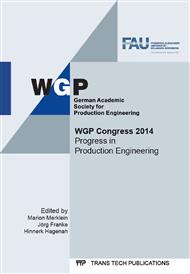[1]
T. Lemken, R. Lucas, J. Acosta, P. D. R. Bleischwitz, C. Kaiser, M. Krause, M. Ritthoff, D. M. Scharp, M. Stürmer and H. Wilts, Verbesserung von Rohstoffproduktivität und Ressourcenschonung Teilvorhaben 1: Potenzialermittlung, Maßnahmenvorschläge und Dialog zur Ressourcenschonung, Publikationen des Umweltbundesamtes, Editor Wuppertal Institut für Klima, Umwelt, Energie GmbH, (2009).
DOI: 10.30844/i40m_22-1_45-47
Google Scholar
[2]
C. Abratis, Biegen von Tailor Rolled Blanks zu Profilen und deren Einsatz im Fahrzeugbau, PhD Thesis, Rheinisch-Westfälische Technische Hochschule Aachen, (2008).
Google Scholar
[3]
M. Kleiner, R. Kopp, W. Homberg, M. Krahn, R. Krux and K. v. Putten, High-Pressure sheet metal forming of tailor rolled blanks, Annals of the WGP, Production Engineering, XI, pp.109-114, (2004).
DOI: 10.1002/srin.200506112
Google Scholar
[4]
A. Weinrich, N. Ben Khalifa, S. Chatti, U. Dirksen and A. E. Tekkaya, Springback Compensation by Superposition of Stress in Air Bending, Key Engineering Materials, 410-411 (2009) 621-628.
DOI: 10.4028/www.scientific.net/kem.410-411.621
Google Scholar
[5]
W. Weißbach, Werkstoffkunde Strukturen, Eigenschaften, Prüfung, 16. überarbeitete Auflage, Wiesbaden: Vieweg & Sohn Verlag (2007).
Google Scholar
[6]
F. I. Saunders. Forming of Tailor-Welded Blanks, PhD Thesis, The Ohio State University, (1994).
Google Scholar
[7]
R. Kopp and P. Böhlke, Herstellung und Weiterverarbeitung von Individuell an den Belastungsfall Angepassten Blechen, Marktchance Individualisierung, (2003) 43-52.
DOI: 10.1007/978-3-642-55495-7_4
Google Scholar
[8]
G. Gantar, T. Pepelnjak and K. Kuzman, Optimization of sheet metal forming processes by the use of numerical simulations, Journal of Materials Processing Technology, Vol. 130-131, pp.54-59 (2002).
DOI: 10.1016/s0924-0136(02)00786-0
Google Scholar
[9]
A. Seto, T. Yamamoto and T. Niwa, Influences of loading direction and thickness ratio on fatigue properties of tailored welded blanks, International Journal of Fatigue, 29 (4), pp.729-737 (2007).
DOI: 10.1016/j.ijfatigue.2006.06.008
Google Scholar
[10]
C. Abratis, G. Hirt, and R. Kopp, Air bending process for load optimised profiles, Steel research international 77 (2006), pp.754-759.
DOI: 10.1002/srin.200606458
Google Scholar
[11]
M. Kleiner, S. Chatti, B. Keller and N. Ridane, Process Chain for Manufacturing of Lightweight Structures Made of Tailor Rolled Blanks, Production Engineering Vol. X/2, pp.15-18 (2003).
Google Scholar
[12]
M. Kleiner, International Patent PCT/AT2007/000142 (2006).
Google Scholar
[13]
A. Weinrich, M. Hermes, S. Chatti und A. E. Tekkaya, Experimental and numerical Investigations on Incremental Stress Superposition on Air Bending, Steel Research International, Special Edition: 14th International Conference Metal Forming, Wiley, Weinheim, Germany, pp.423-426 (2012).
Google Scholar


